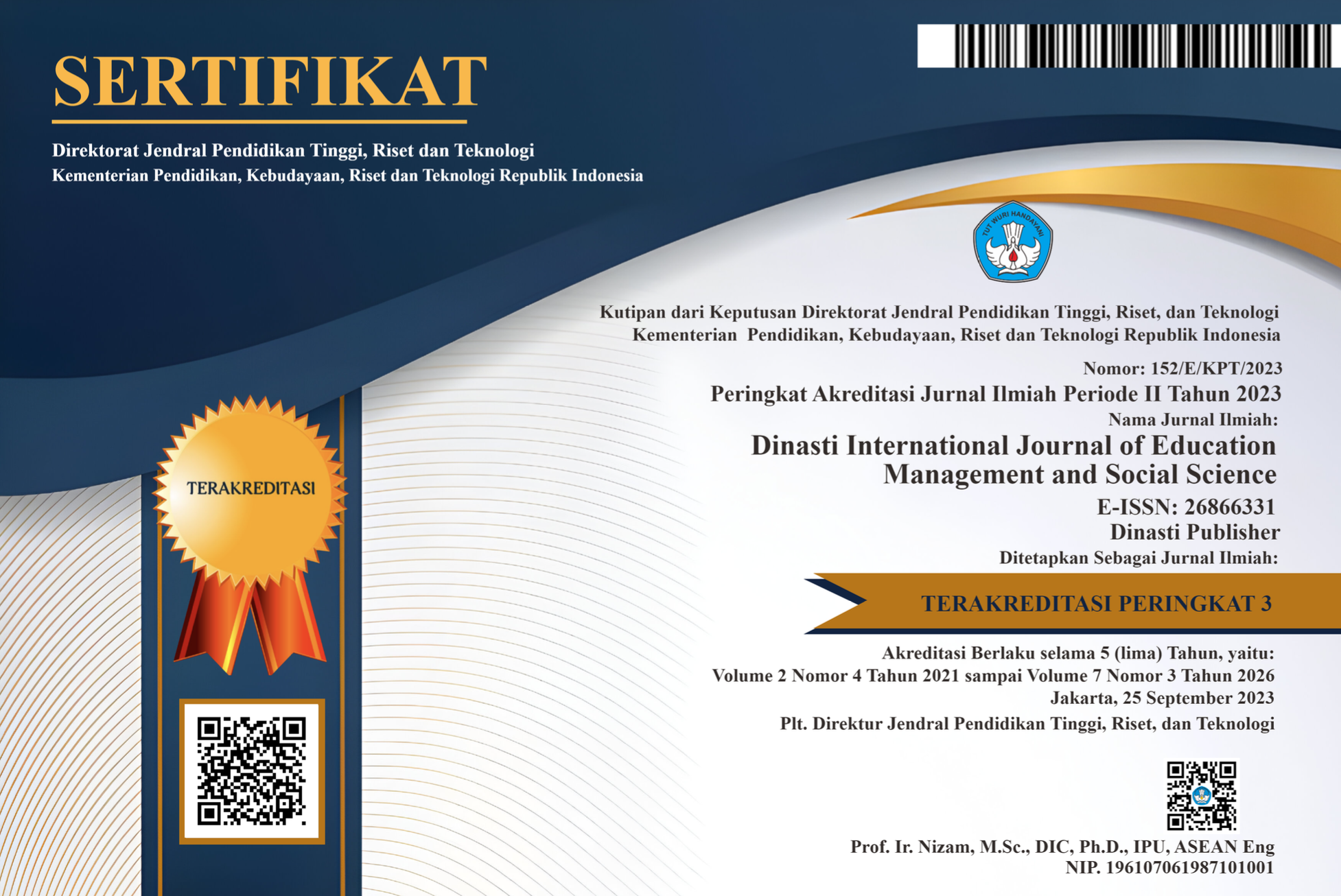The Influence of Place Attachment on Pro-environmental Behaviour Intentions Mediated by Place Satisfaction in Taman Menteng, Jakarta
DOI:
https://doi.org/10.38035/dijemss.v5i5.2689Keywords:
Place Attachment, Place Satisfaction, Pro-Environmental Behaviour, Public SpaceAbstract
This research examines the relationship between place attachment and pro-environmental behavioral intentions which is mediated by the place satisfaction variable. Quantitative analysis is carried out using statistical methods (descriptive, Likert, SEM-PLS) to prove the hypothesis that has been established. Observations were carried out to assess the behavior of park users using behavior mapping analysis as well as assessing the quality of the park based on the Project for Public Spaces. This research has succeeded in collecting data from 148 respondents, all of whom have visited Menteng Park, Central Jakarta. The demographic profile of respondents shows the dominance of female visitors (58.1%) and the majority aged between 25 to 34 years (37.9%). Most respondents came from the Jakarta area (74.3%), indicating that Menteng Park is visited more by local residents. In terms of education, respondents were dominated by undergraduate (41.9%) and high school (39.9%). Analysis of respondents' answers regarding place attachment shows a positive relationship where the result reflects the success of Menteng Park in providing adequate facilities for activities enjoyed by visitors. The results of hypothesis testing show that there is a positive relationship between place attachment, place satisfaction, and pro-environmental behavior intentions in Taman Menteng, Central Jakarta.
References
Casakin, H., Ruiz, C., & Hernández, B. (2021). Place Attachment and the Neighborhood: A Case Study of Israel. Social Indicators Research, 155(1), 315–333. https://doi.org/10.1007/s11205-020-02603-5
Chen, F. F., Sousa, K. H., & West, S. G. (2005). Testing measurement invariance of second-order factor models. In Structural Equation Modeling. https://doi.org/10.1207/s15328007sem1203_7
Devine-Wright, P., & Howes, Y. (2010). Disruption to place attachment and the protection of restorative environments: A wind energy case study. Journal of Environmental Psychology. https://doi.org/10.1016/j.jenvp.2010.01.008
Eizenberg, E., & Jabareen, Y. (2017). Social sustainability: A new conceptual framework. Sustainability (Switzerland), 9(1). https://doi.org/10.3390/su9010068
Gaskin, J., & Lowry, P. (2014). <84. Lowry& Gaskins 2014 PLS Guidelines.pdf>. IEEE Transactions on Professional Communication.
Gosling, E., & Williams, K. J. H. (2010). Connectedness to nature, place attachment and conservation behaviour: Testing connectedness theory among farmers. Journal of Environmental Psychology. https://doi.org/10.1016/j.jenvp.2010.01.005
Hair, J. F., Black, W. C., Babin, B. J., & Anderson., R. E. (2019). Multivariate Data Analysis?: Multivariate Data Analysis?: Why multivariate data analysis?? (EIGHT). CENGAGE.
Halpenny, E. A. (2010). Pro-environmental behaviours and park visitors: The effect of place attachment. Journal of Environmental Psychology, 30(4), 409–421. https://doi.org/10.1016/j.jenvp.2010.04.006
Hernández Bernardo, B., Martín, A. M., Ruiz, C., & Hidalgo, M. del C. (2010). The role of place identity and place attachment in breaking environmental protection laws. Journal of Environmental Psychology. https://doi.org/10.1016/j.jenvp.2010.01.009
Kyle, G., Graefe, A., & Manning, R. (2005). Testing the dimensionality of place attachment in recreational settings. Environment and Behavior, 37(2), 153–177. https://doi.org/10.1177/0013916504269654
Manzo, L. C., & Devine-Wright, P. (2020). Place Attachment. In Place Attachment. https://doi.org/10.4324/9780429274442
Manzo, L. C., & Perkins, D. D. (2006). Finding Common Ground: The Importance of Place Attachment to Community Participation and Planning HOPE VI Impacts Studies View project Global Development of Applied Community Studies View project. Article in Journal of Planning Literature.
Moulay, A., Ujang, N., Maulan, S., & Ismail, S. (2018). Understanding the process of parks’ attachment: Interrelation between place attachment, behavioural tendencies, and the use of public place. City, Culture and Society, 14(December 2017), 28–36. https://doi.org/10.1016/j.ccs.2017.12.002
Pour Ebrahim, N. (2015). Sense of community in new urbanism neighbourhoods: A review. Open House International, 40(4), 25–29.
Project For Public Spaces, P. (2011). Project for Public Spaces. Website.
Raymond, C. M., Brown, G., & Robinson, G. M. (2011). The influence of place attachment, and moral and normative concerns on the conservation of native vegetation: A test of two behavioural models. Journal of Environmental Psychology. https://doi.org/10.1016/j.jenvp.2011.08.006
Sasongko, W., Kurniasanti, R. P., & Siregar, J. P. (2017). The development concept of Taman Aloon-Aloon Tulungagung based on visual accessibility, diversity of activities and perception of users. IOP Conference Series: Earth and Environmental Science, 70(1). https://doi.org/10.1088/1755-1315/70/1/012063
Scannell, L., & Gifford, R. (2010). Defining place attachment: A tripartite organizing framework. Journal of Environmental Psychology, 30(1), 1–10. https://doi.org/10.1016/j.jenvp.2009.09.006
Scannell, L., & Gifford, R. (2017). The experienced psychological benefits of place attachment. Journal of Environmental Psychology, 51, 256–269. https://doi.org/10.1016/j.jenvp.2017.04.001
Sugiyono, D. (2013). Metode Penelitian Pendekatan Kuantitatif, Kualitatif dan R&D.
Vaske, J. J., & Kobrin, K. C. (2001). Place Attachment and Environmentally Responsible Behavior. The Journal of Environmental Education, 32(4), 16–21. https://doi.org/10.1080/00958960109598658
Downloads
Published
How to Cite
Issue
Section
License
Copyright (c) 2024 Aristawidya Bandiani, Wara Indira Rukmi, Wisnu Sasongko

This work is licensed under a Creative Commons Attribution 4.0 International License.
Authors who publish their manuscripts in this journal agree to the following conditions:
- The copyright on each article belongs to the author(s).
- The author acknowledges that the Dinasti International Journal of Education Management and Social Science (DIJEMSS) has the right to be the first to publish with a Creative Commons Attribution 4.0 International license (Attribution 4.0 International (CC BY 4.0).
- Authors can submit articles separately, arrange for the non-exclusive distribution of manuscripts that have been published in this journal into other versions (e.g., sent to the author's institutional repository, publication into books, etc.), by acknowledging that the manuscript has been published for the first time in the Dinasti International Journal of Education Management and Social Science (DIJEMSS).















































